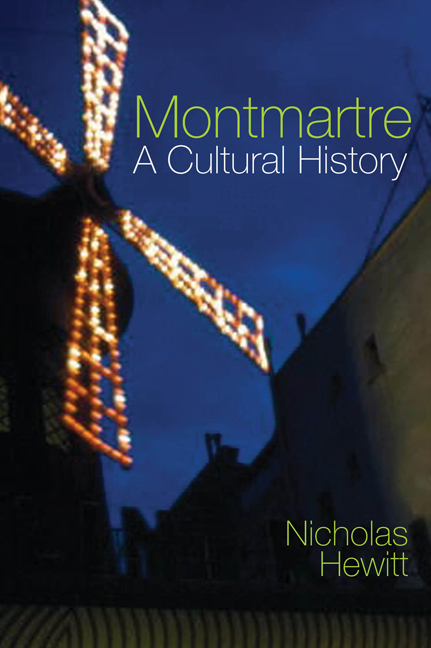Book contents
- Frontmatter
- Dedication
- Contents
- List of Illustrations
- Acknowledgements
- Map
- Introduction
- 1 ‘Montons à la Barrière’
- 2 The Artistic Cabarets
- 3 Music Halls and Mass Culture
- 4 Theatre and the Avant-Garde
- 5 The Bateau-Lavoir and the Lapin Agile
- 6 Wartime and the Années Folles
- 7 The Place of Memory
- 8 The Ecole de Montmartre
- 9 The Occupation: Céline and Aymé
- Epilogue: Montmartre on Film
- Bibliography
- Index
- Plate section
4 - Theatre and the Avant-Garde
- Frontmatter
- Dedication
- Contents
- List of Illustrations
- Acknowledgements
- Map
- Introduction
- 1 ‘Montons à la Barrière’
- 2 The Artistic Cabarets
- 3 Music Halls and Mass Culture
- 4 Theatre and the Avant-Garde
- 5 The Bateau-Lavoir and the Lapin Agile
- 6 Wartime and the Années Folles
- 7 The Place of Memory
- 8 The Ecole de Montmartre
- 9 The Occupation: Céline and Aymé
- Epilogue: Montmartre on Film
- Bibliography
- Index
- Plate section
Summary
If the cabaret culture of the 1880s, following the line of the old Mur des Fermiers Généraux along the border between the ninth and eighteenth arrondisssements, pointed towards the development of Belle Epoque Montmartre as the pre-eminent locus of the capital's popular entertainment industry, with its dancing, music halls, circus, ballet and, later, cinema, it was also the origin of an equally significant innovation in legitimate theatre, which would shape French theatrical practice throughout the twentieth century. Already, as Lucien Farnoux-Reynaud reminds us, the same forces which encouraged dance halls and taverns to proliferate along the lines of the chemins de ronde also led to the establishment at the beginning of the nineteenth century of the théâtres de la barrière which avoided the Napoleonic regime's restrictions in force within the city and which, by the birth of the Third Republic, had established an embryonic theatrical culture in Montmartre. In addition to this, the cabarets, as we have seen, pioneered a new form of entertainment which combined the popular with the intellectual and privileged the performance of the spoken word through dramatic monologues, often cultivating a refined and sophisticated sense of the absurd. At the same time, Henri Rivière's shadow plays for Le Chat Noir combined with a contemporary vogue for puppet theatre to create what was simultaneously a new, protocinematographic, and a primitive, age-old theatrical experience, which would have connections with non-European drama and some of the Cubists’ interests in masks. In addition, the natural symbiosis between cabaret performance and other forms of expression – in particular the publications and comic journals which accompanied them and which gave work to illustrators, artists and writers – was naturally extendable in the field of legitimate theatre through set design, scenery decoration, posters and the production of printed programmes which would be illustrated by some of the major artists of the period. In short, the development of theatre in Montmartre, like that of cabaret and popular entertainment, followed Salis's injunction to be ‘modern’.
Essentially, the history of Montmartre theatre in the Belle Epoque is confined, like that of the cabarets and music halls, to the ninth arrondissement and the southern fringes of the eighteenth, and centres on the role of three innovative theatre directors – André Antoine, Aurélien Lugné-Poe and Charles Dullin.
- Type
- Chapter
- Information
- MontmartreA Cultural History, pp. 86 - 113Publisher: Liverpool University PressPrint publication year: 2017



